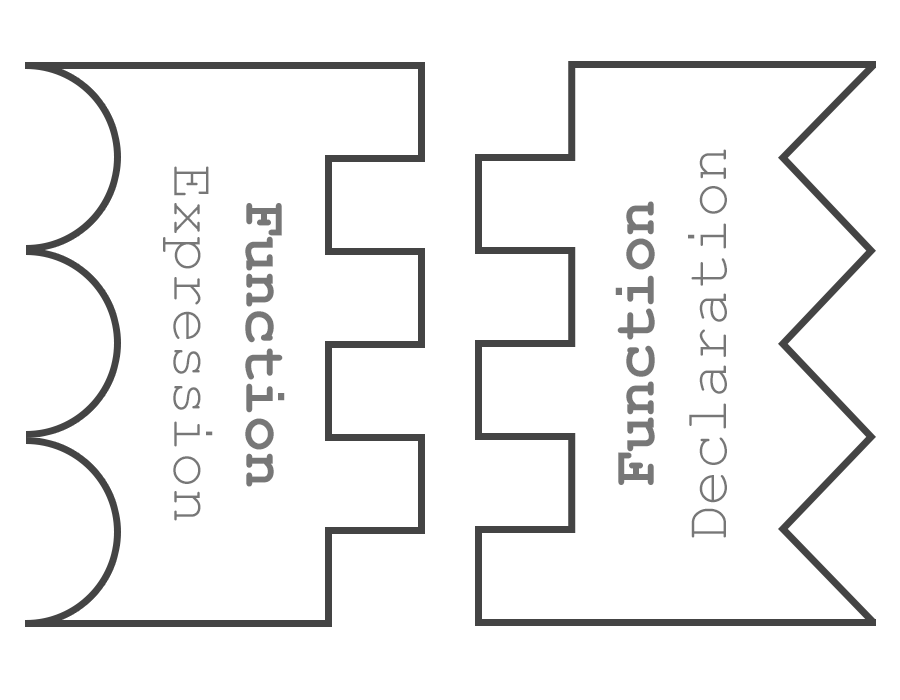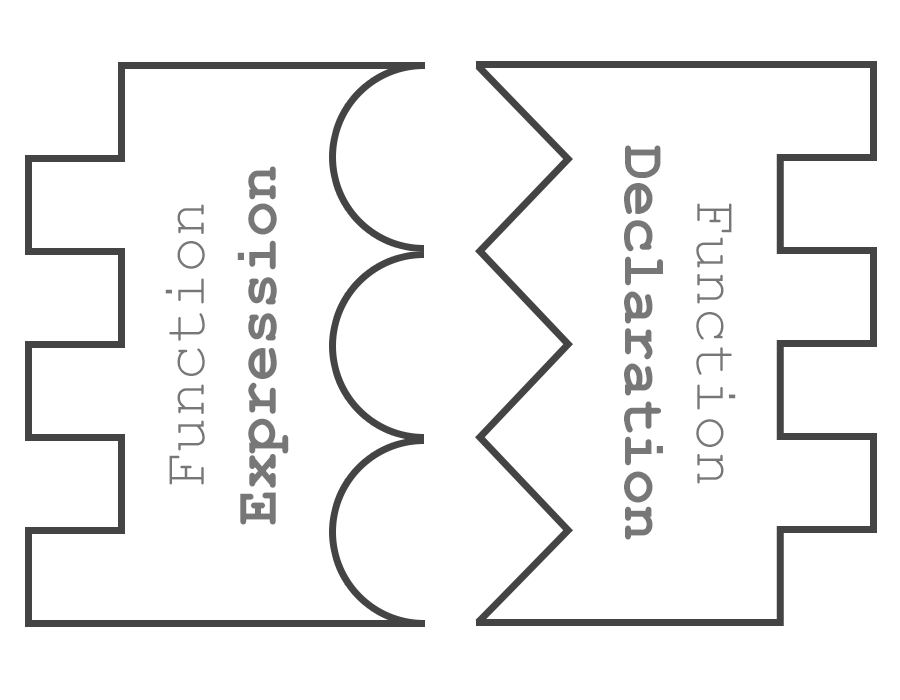
Have you heard about the two ways of declaring a function in JavaScript? Did you use them? Let’s check what you know already by taking this short quiz:
Similarities

Let’s start with similarities: they are both functions.
Functions declared using these two methods (expression and declaration) do not differ in any way. The types of these functions are the same and they behave exactly the same, no matter the definition method.
Differences

But what makes them different then? The most prominent answer is the way they are defined.
Function declaration
In order to define a function using a function declaration, you start declaring a function using the function keyword.
function universeSize () {
return 'immense';
}
Using function declaration you can define a named function. Two important details in function declaration:
- The
functionkeyword should not be preceded by anything else - it is the first word on the line. - Function declaration cannot be nested within non-function blocks (see Migrating one into the other section below).
Similarly to variable declaration using the keyword var, the function declaration defines a variable that is a function right from the start. It is like a special way to define a function. The existence of this method has an explanation and some benefits that are also described below.
Function expression
On the other hand, a function expression is not a stanalone construct, as it defines a function as a part of a larger expression, hence the name. This means that you define a function expression when your definition does not start with the keyword function:
// Anonymous function expression. (starts with `var`)
var universeSize = function () {
return 'immense';
};
// Named function expression. (starts with `var`)
var universeSize = function defineUniverseSize () {
return 'immense';
};
// IIFE (Immediately Invoked Function Expression) (starts with `(`)
(function () {
console.log('The Universe is immense.');
}());
As you can see, function expressions can be named and can be anonymous, whereas function declaration can only be named.
An interesting case is the third case, where the function expression starts with a ( parenthesis. This is also a function expression as it does not start with the function keyword but with the parenthesis character.
Named vs Anonymous Functions
As it was already mentioned, there are named functions and anonymous functions. A named function has a name and an anonymous function doesn’t (aye, Captain Obvious!). But what does this mean?
Generally speaking, a function’s name is what comes after the function keyword. There is a distinction, as you’ll see, between the function’s name and the variable to which that function is assigned.
Names in function declaration
When using function declaration, the name of the function is available both inside its scope and in the scope of its parent.
function universe () {
var age = 13.8e9; // In years
console.log(universe);
}
console.log(universe); // (1)
universe(); // (2)
Both console.log(universe) (1) statement and universe() function call will print out the same thing:
// function universe () {
// var age = 13.8e9; // In years
// console.log(universe);
// }
Names in function expressions
On the other hand, the name of the function defined using a function expression is available only inside the function scope and not in its parent scope.
var universeExpression = function universe () {
var age = 13.8e9; // In years
console.log(universe);
};
universeExpression();
console.log(universe);
In this case, the universeExpression() function call will output this:
// function universe() {
// var age = 13.8e9; // In years
// console.log(universe);
// }
Whereas the console.log(universe) statement will throw a ReferenceError: universe is not defined.
But note that we have an assignment expression. We assign the universe function to the universeExpression variable. Therefore, you have access to the universe function through the universeExpression variable. What you can do though is have the same name for the function and the variable to which that function is assigned.
var universe = function universe () {
var age = 13.8e9; // In years
console.log(universe);
};
universe();
console.log(universe);
In this case, both statements will produce the same result. This is what function declaration implicitly does - it creates a variable with the same name as the function name.
Names in anonymous functions
Well. That’s kinda obvious. Anonymous functions do not have a name, therefore you cannot access them by some name. But there are cases where you do not even need one!
Anonymous functions are quite widespread. One example of their usage is when we loop through an array.
var planets = ['Mercury', 'Venus', 'Earth', 'Mars'];
planets.forEach(function () { /* do stuff here */ }); // Anonymous function!
However, you can assign an anonymous function to a variable and have access to it through that variable.
var explode = function () { /* explode stuff here */ };
Benefits of function declarations
Let’s analyze quiz questions in more detail. Question 1:
function universeIs () {
function dimension () {
return 'gigantic';
}
return dimension();
function dimension () {
return 'enormous';
}
}
console.log(universeIs());
Why the answer to it is 'enormous'? The explanation resides in the way JavaScript interpreter functions. You see, when JavaScript parses the code, upon encountering a function declaration, it automatically moves it up, at the top of the scope it is defined. So, after JavaScript interpreter parsed the code, it looks like this before running the code:
function universeIs () {
// Define the dimension function
function dimension () {
return 'gigantic';
}
// Redefine the dimension function
function dimension () {
return 'enormous';
}
// Return the result of dimension function's invocation
return dimension();
}
console.log(universeIs());
This process of moving parts of code before actually running it is called hoisting.
Hoisting is what allows us to define a function after calling it.
bigBang();
function bigBang() { /* ka-buuuum!!! */ }
The above code works perfectly well, because the function declaration is hoisted to the top.
The benefit of hoisting is that we can organize our code better and we do not need to worry about whether a function is defined already or not yet. We could write the main logic and then, at the end of our script, define the functions taht we use, so you have a separation of logic and additional functions.
Benefits of function expressions
Even if function expressions are not hoisted, they have other advantages over function declarations:
- closures
- arguments to other functions
- Immediately Invoked Function Expressions (IIFE)
Closures
Using function expressions, you can create a closure. One of the simplest example would be the following:
function incrementerBy (index) {
return function (nr) {
// Do stuff here.
// The index variable is available from here.
return index + nr;
};
}
var incrementers = {};
for (var i = 1; i < 4; i++) {
incrementers['by' + i] = incrementerBy(i);
}
console.log(incrementers.by1(2)); // 3
console.log(incrementers.by2(2)); // 4
console.log(incrementers.by3(2)); // 5
Without a closure, we would have this:
function incrementerBy (index) {
return index + nr;
}
var incrementers = {};
for (var i = 1; i < 4; i++) {
incrementers['by' + i] = function (nr) { return i + nr; };
}
console.log(incrementers.by1(2)); // 6
console.log(incrementers.by2(2)); // 6
console.log(incrementers.by3(2)); // 6
Function arguments
Function expressions can be passed directly to functions as function arguments without having to assign the function to an intermediate variable. One such case is the forEach() array method argument.
var planets = ['Mercury', 'Venus', 'Earth', 'Mars'];
planets.forEach(function (planet) { /* do smth with planet */ });
Immediately Invoked Function Expressions (IIFE)
IIFEs prevent JavaScript functions and variables from affecting the global scope. This is achieved by the fact that all the variables and functions withing the IIFE are scoped to the anonymous function, thus remaining unaccessible from the outside. A simple example of an IIFE is the following:
(function () {
// your code here
}());
Note the opening parenthesis ( before the function keyword. This parenthesis transforms the function from a function declaration into a function expression, as it is being defined not starting with a function keyword.
Migrating one into the other
Generally speaking, a function declaration can be very easily converted into a function expression when it either:
- becomes part of an expression (see examples above)
- is no longer a source element of a function or the script itself. A source element is a non-nested statement in the script or a function body:
var a = 0; // source element
if (a === 0) { // source element
a = 1; // not a source element
function earth() {} // not a source element, therefore not a func declaration
}
function universe() { // source element
var b = 10; // source element
function jupiter() {} // source element
while (b === 5) { // source element
function io() {} // not a source element, therefore not a func declaration
b++; // not a source element
}
}
Be careful how you define your functions so that your code works as expected.
Remained questions explanation
Let’s discuss the remained questions and why they provide such results.
Question 2:
console.log(universeIs());
function universeIs () {
var dimension = function () {
return 'gigantic';
};
return dimension();
var dimension = function () {
return 'enormous';
};
}
As you already know, the universeIs function declaration is hoisted to the top, thus making it available at the console.log(universeIs()) statement. But what happens inside the function?
In JavaScript, variable declarations are also hoisted. I won’t dive into it right now, but I highly recommend you Ben Cherry’s article on scoping and hoisting where he addresses it in more detail.
So, after hoisting and before the code is executed, it looks something like this:
console.log(universeIs());
function universeIs () {
var dimension; // First variable declaration hoisted.
var dimension; // Second variable declaration hoisted.
// Function expression assigned to `dimension` variable.
dimension = function () {
return 'gigantic';
};
// Return result of first function expression invokation.
return dimension();
// Second function expression unreachable because of `return` statement.
}
Question 3 is similar in this regard.
Question 4:
function universeIs () {
return dimension();
var dimension = function () {
return 'gigantic';
};
var dimension = function () {
return 'enormous';
};
}
console.log(universeIs());
Can you explain this one yourself? If not yet, let’s analyze it together. This is how the code looks after hoisting variable declarations:
function universeIs () {
var dimension;
var dimension;
// As `dimension` is `undefined` at this point, invoking it as a
// function gives the "TypeError: dimension is not a function"
return dimension();
// Both function expressions are unreachable
}
console.log(universeIs());
Question 5:
function universeIs () {
return 'gigantic';
}();
As already mentioned, function declaration is a standalone construct, so we cannot do anything else except define it. Actually, upon encountering the closing curly brace that ends the function body block, JavaScript will interpret next characters as another statement. So, JavaScript interpreter sees the above example as follows:
function universeIs () {
return 'gigantic';
}
();
And it throws a SyntaxError: Unexpected token ) as this syntax is invalid in JavaScript. However, if you will write:
function universeIs () {
return 'gigantic';
}var lifeExists = true;
You will have both a function and a variable defined and no errors will be thrown.
Question 6:
var universeSize = function () {
return 'gigantic';
}();
console.log(universeSize);
Here, the anonymous function expression can be invoked immediately after its definition and no errors will be thrown. The result of the function execution is assigned to the universeSize variable.
Conclusion
Now you know the difference between function declarations and function expressions.
Is there any preferred way?
Not really. You saw what they are capable of and what their limitations are, so select the proper way according to your needs.
PS: There is actually a third type to declare a function using the new Function() constructor, but this a topic for another post.
Want to challenge yourself once more? You should do better on this one, as now you are armed with all the needed information!
